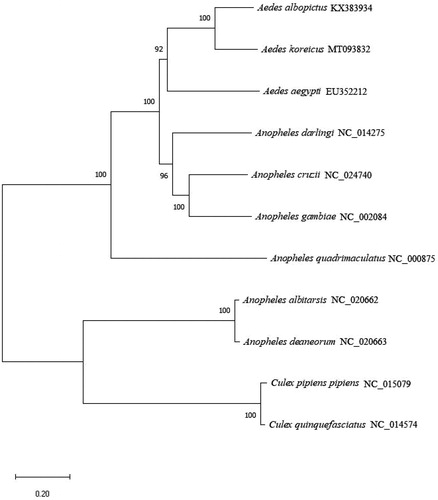Abstract
In this study, we first determined the mitochondrial genome sequence of Aedes koreicus collected in South Korea. Its mitochondrial genome is 15,840 bp in length and consists of 13 protein-coding genes, 22 transfer-RNA genes, 2 ribosomal-RNA genes, and a non-coding A + T rich region. The overall base composition in the heavy strand was as follows: A, 40.1%; G, 8.7%; C, 13.6%; T, 37.5%; and the G + C content was 22.4%. Phylogenetic analysis revealed that Aedes spp. form a monophyletic group.
Aedes mosquitoes transmit viruses that cause various fatal diseases (Alphey et al. Citation2013). For example, A. albopictus and A. aegypti transmit Zika virus and yellow fever, respectively (Lambrechts et al. Citation2010). Aedes koreicus, which is endemic to East Asia, including Korea, Japan, and China, belongs to the same genus as A. albopictus (Tanaka and Es Citation1979). The possibility of viral vectors of this species is currently under study (Ciocchetta et al. Citation2018). According to the available research regarding its native range, A. koreicus is more tolerant toward low winter temperatures than A. albopictus and A. japonicus (Marcantonio et al. Citation2016). Therefore, owing to these characteristics, this species has rapidly expanded outside its native range and invaded Europe, since its first detection in Belgium (Versteirt et al. Citation2012). Unfortunately, there is scant information available on the biology or genetics of this species (Capelli et al. Citation2011).
Here, we first confirmed the mitochondrial genome sequence of A. koreicus (GeneBank accession number: MT093832). We collected an A. koreicus individual from Anyang-si, South Korea (geographic location: 37°22′10.0″N 126°57′37.9″E) in June 2018 using a net. The individual was preserved in 80% ethanol and stored in the Ewha Womans University Natural History Museum of Korea with accession number EWNHM-DONATION-IN-1. The mtDNA was sequenced using Illumina Novaseq 6000. MITObim was used for the assembly of the complete mitochondrial genome, which was then annotated using MITOS.
The length of the mitogenome of A. koreicus is 15,840 bp, and it consists of 13 protein-coding genes, 22 transfer-RNA genes (tRNA), 2 ribosomal-RNA genes (rRNA), and a non-coding A + T-rich control region. For the 13 protein-coding genes, the most common shared start codon is ATG (COX2, ATP6, COX3, ND5, ND4, CYB) followed by ATT (ND2, ATP8, ND3). The most common termination codon is TAA (ND2, AT6, COX2, ND3, ND5, ND4, ND4L, ND6, ND1), followed by the incomplete termination codon T– (COX1, COX2, CYTB). The overall mitochondrial base composition of this genome is A: 40.1%, T: 37.5%, G: 8.7%, and C: 13.6%, with a G + C content of 22.4%.
To explore the phylogenetic relationship within Culicidae, especially to determine whether A. koreicus is genetically similar to mosquito species acting as viral vectors of diseases including chikungunya and dengue, we investigated the molecular phylogenetic relationship among Culicidae species using the complete mitochondrial genome sequence of 10 species ().
Figure 1. Phylogenetic tree of 11 species within Culicidae constructed using the neighbor-joining algorithm based on complete mosquito mitochondrial genomes. Genbank accession no.: Aedes koreicus (MT093832), Ae. albopictus (KX383934), Ae. Aegypti (EU352212), Anopheles darling (NC_014275), An. cruzii (NC_024740), An. gambiae (NC_002084), An. quadrimaculatus A (NC_000875), An. albitarsis (NC_020662), An. deaneorum (NC_020663), Culex pipiens pipiens (NC_015079), Cx. quinquefasciatus (NC_014574).

The phylogenetic analysis of mosquito mitochondrial genomes was performed with MEGA X (Kumar et al. Citation2018) using the neighbor-joining algorithm. The results revealed that Aedes species form a monophyletic clade.
Disclosure statement
No potential conflict of interest was reported by the author(s).
Data availability
The data that support the findings of this study are openly available in Mendeley Data at http://doi.org/10.17632/j7ttvdnh72.1.
Additional information
Funding
References
- Alphey L, McKemey A, Nimmo D, Neira Oviedo M, Lacroix R, Matzen K, Beech C. 2013. Genetic control of Aedes mosquitoes. Pathog Glob Health. 107(4):170–179.
- Capelli G, Drago A, Martini S, Montarsi F, Soppelsa M, Delai N, Ravagnan S, Mazzon L, Schaffner F, Mathis A, et al. 2011. First report in Italy of the exotic mosquito species Aedes (Finlaya) koreicus, a potential vector of arboviruses and filariae. Parasites Vectors. 4(1):188.
- Ciocchetta S, Prow NA, Darbro JM, Frentiu FD, Savino S, Montarsi F, Capelli G, Aaskov JG, Devine GJ. 2018. The new European invader Aedes (Finlaya) koreicus: a potential vector of chikungunya virus. Pathog Glob Health. 112(3):107–114.
- Kumar S, Stecher G, Li M, Knyaz C, Tamura K. 2018. MEGA X: molecular evolutionary genetics analysis across computing platforms. Mol Biol Evol. 35(6):1547–1549.
- Lambrechts L, Scott T W, Gubler D J. 2010. Consequences of the Expanding Global Distribution of Aedes albopictus for Dengue Virus Transmission. PLoS Negl Trop Dis. 4(5):e646
- Marcantonio M, Metz M, Baldacchino F, Arnoldi D, Montarsi F, Capelli G, Carlin S, Neteler M, Rizzoli A. 2016. First assessment of potential distribution and dispersal capacity of the emerging invasive mosquito Aedes koreicus in Northeast Italy. Parasites Vectors. 9(1):63.
- Tanaka K, Es S. 1979. A revision of the adult and larval mosquitoes of Japan (including Ryukyu Archipelago and the Ogasawara Islands) and Korea (Diptera: Culicidae). Contrib Am Entomol Inst. 16:1–987.
- Versteirt V, De Clercq EM, Fonseca D, Pecor J, Schaffner F, Coosemans M, Van Bortel W. 2012. Bionomics of the established exotic mosquito species Aedes koreicus in Belgium. Jnl Med Entomol. 49(6):1226–1232.
